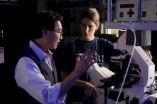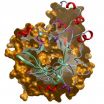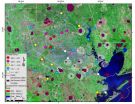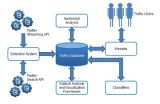(Press-News.org) DURHAM, N.C. – Duke University bioengineers have not only figured out a way to sneak molecular spies through the walls of individual cells, they can now slip them into the command center -- or nucleus -- of those cells, where they can report back important information or drop off payloads.
Using silver nanoparticles cloaked in a protein from the HIV virus that has an uncanny ability to penetrate human cells, the scientists have demonstrated that they can enter the inner workings of the nucleus and detect subtle light signals from the "spy."
In order for these nano-spies to be effective, they not only need to get through the cell's first line of defense -- the cell wall -- they must be able to enter the nucleus.
The ultimate goal is to be able to spot the earliest possible moment when the genetic material within a cell begins to turn abnormal, leading to a host of disorders, especially cancer.
The finding also shows how drugs or other payloads might be delivered directly into the nucleus.
"This new method of getting into and detecting exactly what is going on in the nucleus of cell has distinct advantages over current methods," said Molly Gregas, a graduate student in the laboratory of Tuan Vo-Dinh, R. Eugene and Susie E. Goodson Distinguished Professor of Biomedical Engineering, professor of chemistry and director of The Fitzpatrick Institute for Photonics at Duke's Pratt School of Engineering.
"The ability to place these nanoparticles into a cell's nucleus and gather information using light has potential implications for the selective treatment of disease," Gregas said. "We envision that this approach will also help basic scientists as they try to better understand what occurs within a cell's nucleus."
The Duke researchers reported their findings in a series of papers, culminating in the latest issue of Nanomedicine, which was published online. The research was supported by the National Institutes of Health.
The researchers coupled miniscule particles of silver, a metal that is not rejected by cells and is an efficient reflector of light, with a small portion of the HIV protein responsible for its highly efficient ability to enter a cell and its nucleus. In this case, the researchers harnessed only the ability of HIV to sneak past cellular defenses, while stripping away its ability to take over the cell's genetic machinery and cause disease.
"This combination takes advantage of the smallness of the nanoparticle and the 'delivery instructions' of the HIV protein," Gregas explained. "Once we can get that nanoparticle into the nucleus, we have many options. We can for example deliver some sort of payload and then observe its effects within the nucleus."
That's where a four-decades-old optical technique known as surface-enhanced Raman scattering (SERS) comes into play. It is used here as a sensitive imaging technique to demonstrate that the nanoparticles and their payloads successfully entered the nucleus.
When light, usually from a laser, is shined on a sample, the target molecule vibrates and scatters back its own unique light, often referred to as the Raman scatter. However, this Raman response is extremely weak. When the target molecule is coupled with a metal nanoparticle, the Raman response is greatly enhanced by the SERS effect -- often by more than a million times, Vo-Dinh said.
In the early 1980s, while at the Oak Ridge National Laboratory in Tennessee, Vo-Dinh and colleagues were among the first to demonstrate that SERS could be put into practical use to detect chemicals, including carcinogens, environmental pollutants and early markers of disease. At Duke, Vo-Dinh is pushing the boundaries of SERS technology for biomedical detection and molecular imaging.
"Our ultimate goal is to develop a nanoscale delivery system that can drop off its payload – in this case nanoparticles with other agents attached -- into a cell to enhance the effectiveness of a drug treatment," Vo-Dinh said. "Theoretically, we could 'load up' these nanoparticles with many things we are interested in -- for example a nanoprobe for a cancer gene -- and get it into a cell's nucleus. This would provide us a warning signal of the disease at its earliest stage, thus allowing faster and more effective treatment."
The current experiments were conducted with living cells in the laboratory. New experiments are focusing on using this approach in animal models to determine how it works in a complex living system.
INFORMATION:
Other Duke engineering members of the research team include Fei Yan, Jonathan Scaffidi, Hsin-Neng Wang and Benoit Lauly. Victoria Seewaldt of Duke's Comprehensive Cancer Center also participated in the research.
Sneaking spies into a cell's nucleus
2010-09-29
ELSE PRESS RELEASES FROM THIS DATE:
DMARDs, glucocorticoids and biologics equally effective for rheumatoid arthritis
2010-09-29
A study conducted at Copenhagen University Hospital showed that treatment of rheumatoid arthritis (RA) with disease modifying antirheumatic drugs (DMARDs), glucocorticoids, biologic agents, or a combination of agents significantly reduced radiographic evidence of joint destruction, with a relative effect of 48%% as compared with placebo. A direct comparison between the combination of a biologic agent plus methotrexate and the combination of 2 DMARDs plus initial glucocorticoids revealed no difference. Study findings are published in the October issue of Arthritis ...
Heartbreak puts the brakes on your heart
2010-09-29
Social rejection isn't just emotionally upsetting; it also upsets your heart. A new study finds that being rejected by another person makes your heart rate drop for a moment. The study is published in Psychological Science, a journal of the Association for Psychological Science.
Research has shown that the brain processes physical and social pain in some of the same regions. Bregtje Gunther Moor, Eveline A. Crone, and Maurits W. van der Molen of the University of Amsterdam and Leiden University in the Netherlands wanted to find out how social pain affects you physically. ...
Abatacept found ineffective in treatment of non-life threatening lupus
2010-09-29
Results from a 12-month multi-center clinical trial did not show therapeutic benefit of abatacept over placebo in patients with non-life threatening systemic lupus erythematosus (SLE). Abatacept failed to prevent new disease flares in SLE patients tapered from corticosteroids in an analysis where mild, moderate and severe disease flares were evaluated together. Full details of the phase IIb clinical trial are published in the October issue of Arthritis & Rheumatism, a journal of the American College of Rheumatology (ACR).
The ACR estimates that 161,000 to 322,000 adults ...
Structural Genomics Consortium releases 1,000th protein structure
2010-09-29
The Structural Genomics Consortium (SGC), an international public-private partnership that aims to determine three dimensional structures of medically important proteins, announced today the release into the public domain of its 1000th high resolution protein structure.
The 1000th structure – known as JmjD2C – belongs to a class of proteins involved in epigenetic signalling, a key research area for the SGC. Epigenetics is the study of inherited changes in gene expression caused by proteins such as JmjD2C which 'switch' genes on or off. It is believed that a better understanding ...
UH geologists find parts of Northwest Houston sinking rapidly
2010-09-29
HOUSTON, Sept. 28, 2010 – A large section of northwestern Harris County – particularly the Jersey Village area – is sinking rapidly, according to a University of Houston (UH) geologist who has analyzed GPS data measuring ground elevation in the Houston area.
Some points in Jersey Village are subsiding by up to 5.5 centimeters (about 2 inches) a year, said Shuhab Khan, an associate professor of geology at UH. Khan, along with UH geology professor Kevin Burke and former Ph.D. student and UH alumnus Richard Engelkemeir, studied a decade's worth of detailed GPS data measuring ...
AMIA cites concerns about proposed HIPAA modifications
2010-09-29
In comments sent to Secretary Kathleen Sebelius at the U.S. Department of Health and Human Services, AMIA (American Medical Informatics Association) called out 10 specific challenges to proposed modifications to HIPAA Privacy and Enforcement Rules. AMIA's comments, sent on behalf of its membership of 4,000 informatics professionals, detail key issues of concern related to the Notice of Proposed Rulemaking (NPRM) on HIPAA modifications, along with suggestions for models of change. The following areas were cited:
Business Associates and Subcontractors
Position: AMIA ...
Smithsonian researchers find differences between Galapagos and mainland frigatebirds
2010-09-29
Although the magnificent frigatebird may be the least likely animal on the Galapagos Islands to be unique to the area, it turns out the Galapagos population of this tropical seabird may be its own genetically distinct species warranting a new conservation status, according to a paper by researchers at the Smithsonian Conservation Biology Institute, the Smithsonian's National Museum of Natural History and the University of Missouri-St. Louis published last week in the scientific journal Proceedings of the Royal Society B.
The Galapagos Islands, which once served as a scientific ...
The dual nature of dew
2010-09-29
When the scientific and spiritual worlds collide, they do so in the most surprising ways. Classical meteorological and plant science has, in the last century, insisted that dew negatively affects plant life, leading to rot and fungus. But in the Judeo-Christian tradition, dew is most welcomed as an important source of vegetative and plant life, celebrated in poetry and prayer.
Now Prof. Pinhas Alpert of Tel Aviv University's Department of Geophysics and Planetary Sciences has developed an explanation for the perplexing paradox with his colleagues. According to scientific ...
Noise and chemicals: Workers are losing their hearing
2010-09-29
A study carried out by Spanish researchers has shown that the presence of chemical contaminants can interact with noise and modify, for good or for bad, the way in which work-related "deafness" – which is increasingly common among young people – manifests itself. Noise-related hearing loss is the most common occupational disease in Europe.
"Workers exposed to noise in the presence of metalworking fluids exhibit a delay in hearing alteration in comparison with those exposed only to noise at the same intensity. However, those exposed to noise in the presence of welding ...
Truthy.indiana.edu to search, identify smear tactics, Twitter-bombs through election runup
2010-09-29
Astroturfers, Twitter-bombers and smear campaigners need beware this election season as a group of leading Indiana University information and computer scientists today unleashed Truthy.indiana.edu, a sophisticated new Twitter-based research tool that combines data mining, social network analysis and crowdsourcing to uncover deceptive tactics and misinformation leading up to the Nov. 2 elections.
Combing through thousands of tweets per hour in search of political keywords, the team based out of IU's School of Informatics and Computing will isolate patterns of interest ...






